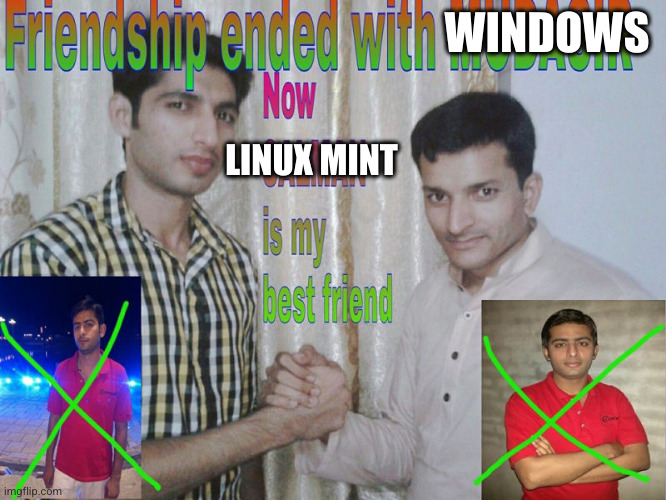this post was submitted on 09 Jun 2024
742 points (95.2% liked)
linuxmemes
22037 readers
1930 users here now
Hint: :q!
Sister communities:
Community rules (click to expand)
1. Follow the site-wide rules
- Instance-wide TOS: https://legal.lemmy.world/tos/
- Lemmy code of conduct: https://join-lemmy.org/docs/code_of_conduct.html
2. Be civil
- Understand the difference between a joke and an insult.
- Do not harrass or attack users for any reason. This includes using blanket terms, like "every user of thing".
- Don't get baited into back-and-forth insults. We are not animals.
- Leave remarks of "peasantry" to the PCMR community. If you dislike an OS/service/application, attack the thing you dislike, not the individuals who use it. Some people may not have a choice.
- Bigotry will not be tolerated.
- These rules are somewhat loosened when the subject is a public figure. Still, do not attack their person or incite harrassment.
3. Post Linux-related content
- Including Unix and BSD.
- Non-Linux content is acceptable as long as it makes a reference to Linux. For example, the poorly made mockery of
sudoin Windows. - No porn. Even if you watch it on a Linux machine.
4. No recent reposts
- Everybody uses Arch btw, can't quit Vim, <loves/tolerates/hates> systemd, and wants to interject for a moment. You can stop now.
5. 🇬🇧 Language/язык/Sprache
- This is primarily an English-speaking community. 🇬🇧🇦🇺🇺🇸
- Comments written in other languages are allowed.
- The substance of a post should be comprehensible for people who only speak English.
- Titles and post bodies written in other languages will be allowed, but only as long as the above rule is observed.
Please report posts and comments that break these rules!
Important: never execute code or follow advice that you don't understand or can't verify, especially here. The word of the day is credibility. This is a meme community -- even the most helpful comments might just be shitposts that can damage your system. Be aware, be smart, don't remove France.
founded 2 years ago
MODERATORS
you are viewing a single comment's thread
view the rest of the comments
view the rest of the comments

my gear
I still use HDDs because my 2 PCs are very old. But they both run versions of Linux mint 21.3 (the current release) without issue. Mint xfce on my 15 year old optiplex with 4Gb ram.(because 2 slots are fried) My other different model optiplex (also about 15 years old) has mint xfce, mint, another mint (different purposes) a shared volume, a timeshift partition (snapshots) on a 1tb hdd and windows on its original 320mb drive. 8Gb ram, onboard video, external soundcard
things
Over clocking on Linux... Not sure if necessary? Linux uses a CPU governor which throttles or maxes CPU based on .. Things. Same with memory.I don't play games, but I do run other processor heavy stuff. I know nvidia has/had issues depending on certain seemingly random things. Their drivers, I believe, are mostly NOT open source.
WINE is a godsend, especially the latest version 8. Wine gives you the ability to natively rum most windows apps. (Some run better on Linux, lol) You could install windows as a VM, too. But wine works for what I need (fl studio basically)
booting issues
If you dual boot, windows must be installed first. Windows (MBR) and Linux (GPT or MBR) use different partition table types. Windows stores the boot loader in the MBR (master boot record) which is usually the first 100mb of a disk. Linux gpt can install boot record to disk (/dev/sda), to disk boot partition(/dev/sda6), and to BIOS. Windows will often overwrite the Linux boot loader (GRUB) Boot menus in Linux are fully customisable text files. They can be simple text menus, or fancy graphical ones. When GRUB is.used it finds other OSs on your disks. It makes a menu. It works. Separate drives helps. Linux isn't limited to 4 logical volumes or the need for extended partitions. Linux can see all filesystem types. Windows?::: filesystem's Linux uses a fuckton of different filesystems for different functions (Linux is at its core -simple, but it is voluminous in the knowledge base - 15 years later and I'm still going, 'oh, that's cool, I didn't know I could do that) Anyway, the main fs on Linux is ext4, but it can read/write/modify NTFS, fat, vfs, luks, and on and on. Windows does NTFS and fat. :::
::: don't be scared The terminal is actually, really, truly, for real, your best friend and portal to power potential :::
Resources may seem overwhelming at first. Linux uses a lot of words to do things. The GUI has gotten prettier, but the real customisation comes in text files(all of Linux is text files) there's not registry that is mostly unreadable/unusable.
Linux manages resources much better (Maybe because it doesn't try to stuff ads all over the place and spy on you)
Use the manpages man7.org or sjmilar Use archwiki.org Use bash.org Use your distros site (or use Ubuntu.com or Debian.org for deb/Ubuntu variants like mint)
Learn your package manager. (Apt, pacman, whatever it is). Install apps from there. Unless trusted or you've reviewed the code, avoiding installation from websitez is good practice.
Everything is a text file. Configuration files are usually easily readable and configurable. Though some may be in json and some in Java and some in Matlab and some in sh and some in plaintext (the joys of not having monolithic monopolies controlling everything)
Anyway. Its late. I've rambled. Happy fossing